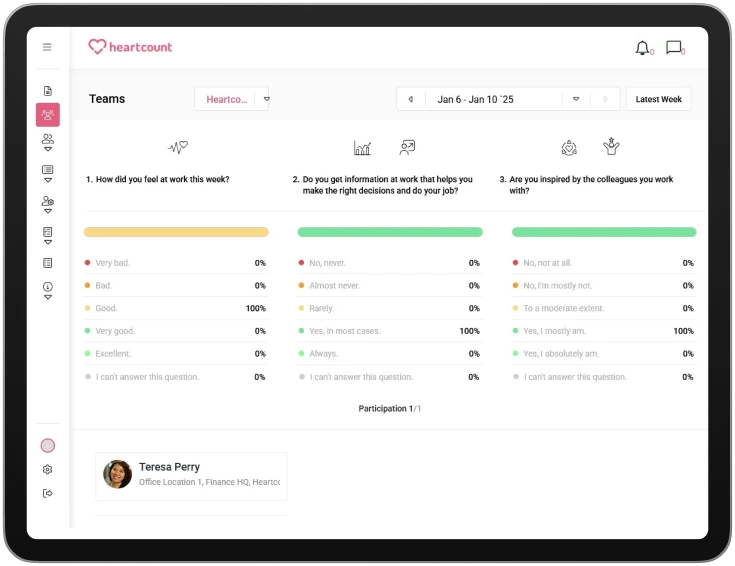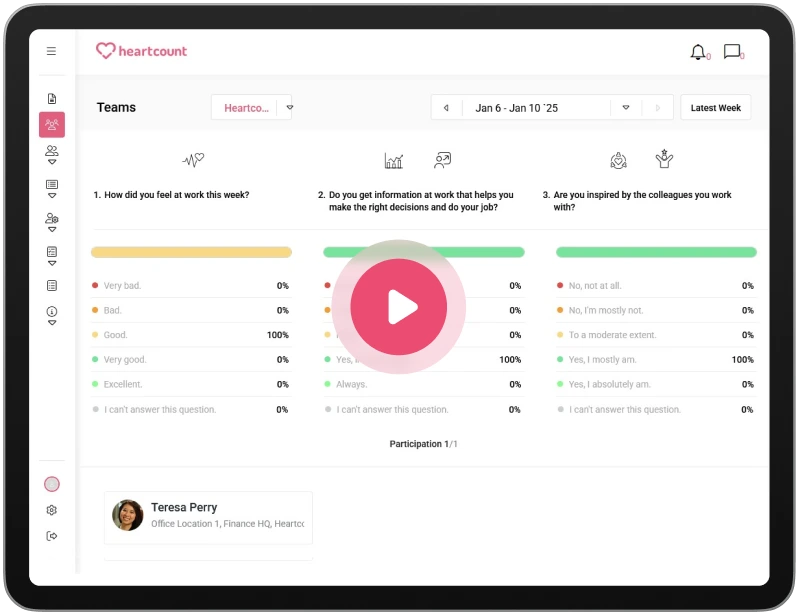Employee burnout: causes and cures

Burnout is more than just having a bad day or feeling stressed and tired; it’s a long-term state, most of the time caused by overwork, that can seriously affect an employee’s mental and physical health.
According to the World Health Organization’s (WHO) handbook, the International Classification of Diseases (ICD-11), burnout is a legitimate medical diagnosis.
Dr. Frank Drummond, chief medical officer of behavioral health services at HCA Healthcare, explained that burnout has been since 2003 classified as a symptom – a problem related to life management – but was recently updated as a syndrome resulting from “chronic workplace stress.”
Burnout affects 70% of employees, so it’s important to take it seriously. When employees experience burnout, they feel tired, less motivated, and might even face health problems. High burnout levels also hurt organizations because it leads to lower productivity, increased absenteeism, and higher turnover rates.
By addressing burnout, companies can create healthier work environments and improve employee satisfaction while also improving their overall success.
Burnout is more than just having a bad day or feeling stressed and tired; it’s a long-term state, most of the time caused by overwork, that can seriously affect an employee’s mental and physical health.
According to the World Health Organization’s (WHO) handbook, the International Classification of Diseases (ICD-11), burnout is a legitimate medical diagnosis.
Dr. Frank Drummond, chief medical officer of behavioral health services at HCA Healthcare, explained that burnout has been since 2003 classified as a symptom – a problem related to life management – but was recently updated as a syndrome resulting from “chronic workplace stress.”
Burnout affects 70% of employees, so it’s important to take it seriously. When employees experience burnout, they feel tired, less motivated, and might even face health problems. High burnout levels also hurt organizations because it leads to lower productivity, increased absenteeism, and higher turnover rates.
By addressing burnout, companies can create healthier work environments and improve employee satisfaction while also improving their overall success.
What is employee burnout?
Employee burnout is a serious condition where a person feels completely drained—physically, emotionally, and mentally—because of too much stress at work. It happens when someone works so hard or deals with so much pressure over an extended portion of time without break, support, or acknowledgment that they simply come to the point where they feel they can’t keep up anymore.
World Health Organization (WHO) defines it like this:
“Burnout is a syndrome conceptualized as resulting from chronic workplace stress that has not been successfully managed. It is characterized by three dimensions: 1) feelings of energy depletion or exhaustion; 2) increased mental distance from one’s job, or feelings of negativism or cynicism related to one’s job, and 3) reduced professional efficacy.”
Burnout doesn’t happen overnight; it builds up over time as workplace stress piles on without proper breaks or solutions.
When a person is burned out, they often feel like nothing they do at work makes a difference. They might feel detached from their job, lose interest in tasks they used to enjoy, and struggle to keep up with their responsibilities. Burnout, as described by Emily and Amelia Nagoski in their book Burnout, is the result of accumulated stress that remains unresolved in our bodies, like a cycle that never reaches its conclusion. This condition is not just a physiological reaction but also emotional exhaustion caused by constant exposure to stressors, whether at work or in everyday life. Burnout often leads to feelings of fatigue and loss of creativity, and it can become chronic if steps are not taken to process and complete the stress cycle.
According to the authors, it is crucial to distinguish between stress and stressors and to find ways for the body to complete its stress response—whether through physical activity, connection with others, or emotional expression—to avoid long-term consequences for mental and physical health.
The most common causes of burnout
Burnout doesn’t happen randomly; it is usually the result of ongoing challenges in the workplace. The leading causes of employee burnout:
1. Excessive workload
One of the most obvious causes of burnout is having too much work to do. Employees who are constantly juggling deadlines, multitasking, or working long hours often feel overwhelmed.
When the workload is too heavy, without an option to lower the pace over the month or quarter, it leaves little to no time for rest or recovery. This causes stress to build up over time. Even highly motivated individuals can burn out if their responsibilities exceed what they can realistically handle over an extended period of time.
Employers can address this cause by improving employee morale and offering better employee well-being programs.
2. Lack of control
Feeling powerless at work is another major factor in burnout. This happens when employees don’t have enough say in decisions that affect their jobs, like work schedules, task assignments, or deadlines.
When people feel like they have no control over their work, it leads to frustration and a sense of helplessness, which causes burnout.
Ensuring job satisfaction through better management and communication can help reduce this issue.
3. Unclear expectations
When employees don’t know exactly what is expected of them, it creates uncertainty and stress. Vague or shifting job responsibilities can leave employees feeling confused and insecure about their performance. This constant guessing game about whether they are doing the “right” thing adds unnecessary stress to their work.
While mid-year reviews are a good time for deeper and longer one-on-one conversations to understand if everyone is on the same page, it’sa good idea to create multiple points and possibilities for conversation and feedback loops during the day-to-day operations.
4. Insufficient reward
Burnout can also stem from a lack of recognition or reward for hard work.
Employees who feel undervalued—whether in terms of pay, promotions, or simple appreciation—may lose motivation over time.
If workers believe their efforts go unnoticed, it can lead to resentment and disengagement. Offering thoughtful employee benefits can help combat this.
5. Unfair treatment
When employees face bias, favoritism, or unequal workloads, it creates a toxic work environment.
Unfair treatment can cause stress, lower morale, and create feelings of anger or frustration.
When people don’t feel respected or treated equally, they are much more likely to experience burnout. Building a culture of collaboration can help address unfair treatment and promote inclusivity.
6. Value conflict
Burnout is common when there’s a disconnect between an employee’s personal values and their job.
For example, someone who values creativity might feel stifled by micromanagement in a rigid or bureaucratic workplace. If employees feel they are compromising their principles or working against their beliefs, it can lead to emotional exhaustion and dissatisfaction.
Supporting employee sentiment can help align values with the workplace. Also, creating a culture of belonging with careful hiring, onboarding, and continuous actions can benefit everyone in the long run.
7. Poor work-life balance
A healthy balance between work and personal life is crucial to preventing burnout.
When work takes up too much time or energy, leaving no room for family, hobbies, or relaxation, employees can feel trapped. Over time, the lack of downtime makes it harder to recharge and recover from stress, increasing the risk of burnout.
Encouraging flexible schedules and focusing on employee well-being can help achieve better balance.
By addressing these common causes, organizations can help improve employee engagement and ensure reduced turnover. Understanding and resolving these issues will promote long-term wellness and productivity in the workplace.
COLLECT
How to recognize employee burnout
Burnout is a prolonged state of workplace stress that impacts an employee’s physical health, emotional well-being, and behavior.
We conducted research via LinkedIn among a variety of employed people, asking them about their experiences with burnout—how they recognized it and what specific situations contributed to it.
Many shared that burnout left them feeling completely drained, even after long periods of rest, with some experiencing physical symptoms like headaches and tension just from thinking about work. Others noticed burnout affecting all areas of their lives, with exhaustion persisting despite extended naps or downtime. They described feelings of dread before starting work, difficulty concentrating, and heightened anxiety or stress over minor issues.
Burnout often starts subtly, with employees feeling slightly more tired or irritable than usual. Over time, if the underlying causes are not addressed, these feelings grow into significant physical, emotional, and behavioral changes.
Dr Julie Smith, clinical psychologist, warns of the following burnout signs:
Recognizing burnout early is important because it affects the individual and harms workplace productivity, team morale, and overall employee engagement.
1. Physical burnout symptoms
Burnout has a noticeable effect on the body. Employees who experience burnout may frequently complain about feeling physically unwell, which stems from the body’s inability to recover from constant stress.
Physical symptoms can make even simple tasks feel overwhelming, further decreasing an employee’s ability to perform effectively.
Common symptoms include:
- Chronic fatigue: Employees often feel persistently drained, regardless of how much rest they get. This fatigue is a deep exhaustion that affects energy levels throughout the day.
- Sleep problems: Many burned-out employees struggle to fall asleep or wake up feeling unrefreshed, which further contributes to their lack of energy.
- Frequent illnesses: Stress weakens the immune system, leaving individuals more vulnerable to colds, infections, and other health issues.
- Aches and pains: Headaches, backaches, and neck pain are common physical manifestations of stress from burnout.
2. Emotional burnout symptoms
The emotional toll of burnout can be just as severe as the physical effects. Employees may feel emotionally drained, which impacts how they perceive their work and relationships.
If left unaddressed, these emotional challenges can lead to more serious mental health concerns, such as anxiety or depression.
Emotional indicators include:
- Feelings of detachment: Employees may feel disconnected from their jobs, coworkers, or the goals of the organization. Emotional distance can make them indifferent to work outcomes. Tasks that used to be interesting or exciting now feel boring or pointless. This shift in employee attitude often leads to cynicism, where employees think, “Why does this even matter?”
- Irritability or mood swings: Burnout often makes individuals more short-tempered or prone to frustration over small issues.
- Loss of motivation: Tasks that once felt meaningful or enjoyable may now feel pointless or overwhelming, leading to a lack of enthusiasm.
- Sense of failure or self-doubt: Employees may feel they’re not accomplishing enough or believe they’re inadequate in their role, even if they’re meeting expectations.
3. Behavioral burnout symptoms
Burnout can change how employees behave at work, sometimes in ways that are easier for managers or coworkers to spot.
Burned-out employees may exhibit the following behaviors:
- Withdrawal from responsibilities: Employees might start procrastinating, missing deadlines, or avoiding specific tasks they find particularly stressful.
- Social isolation: They may disengage from team activities, avoid interactions with colleagues, or stop contributing to meetings.
- Decreased productivity: Burned-out employees often struggle to focus, leading to more mistakes or a noticeable drop in their usual performance.
- Higher absenteeism: Employees may take more sick days or frequently leave work early, using any excuse to escape workplace as it stresses them out just being present there.
How does employee burnout affect organizations and employees?
Burnout is not just a personal issue—it has far-reaching consequences for both employees and the organizations they work for.
When employees experience burnout, their mental and physical health, job satisfaction, and productivity suffer. For companies, the impacts are equally severe, ranging from reduced efficiency to increased costs and damaged workplace culture.
Understanding the negative consequences of burnout is important for addressing the problem and creating a healthier, more productive work environment.
Negative consequences for employees
Burnout deeply affects employees on a personal level, often spilling over into their personal lives and long-term well-being. Here’s how it impacts individuals:
- Physical and mental health issues:
The American Psychological Association’s Work and Wellbeing Survey found that 3 in 5 workers experienced negative mental and physical effects from work-related stress.
Specifically, 26% reported low motivation or energy, 32% experienced emotional exhaustion, and 44% faced severe physical fatigue. Chronic stress can lead to headaches, sleep disturbances, high blood pressure, and weakened immunity.
Mentally, employees may struggle with anxiety, depression, or feelings of hopelessness, which further affects their ability to function effectively at work.
- Decreased job satisfaction:
Employees experiencing burnout often lose interest in their work and feel disconnected from their roles. Tasks that once brought them satisfaction now feel like an uphill battle.
This disconnection can lead to dissatisfaction and resentment, making it difficult for them to stay motivated.
- Reduced performance:
Burnout leads to exhaustion and impaired focus, making it harder for employees to complete tasks effectively.
Mistakes, missed deadlines, and a drop in the quality of work are common, which further contributes to feelings of inadequacy.
- Damaged personal life:
Burnout doesn’t stop at the workplace—it often spills into personal relationships.
Exhaustion and irritability can make it harder for employees to engage with family and friends, leading to strained relationships and further isolation.
Negative consequences for companies
For organizations, employee burnout can lead to significant challenges that affect performance, reputation, and costs. Some of the key impacts include:
- Reduced productivity:
Burnout decreases employees’ ability to perform at their best. Mentally and physically drained employees struggle to focus, make more errors, and work at a slower pace.
This drop in productivity can harm an organization’s overall performance.
- Higher absenteeism:
Burned-out employees are likelier to call in sick or take frequent mental health days. Chronic stress can also lead to long-term health issues, requiring extended absences.
This inconsistency in attendance disrupts workflows and creates additional strain on teams.
- Increased turnover:
Employees who feel overworked, undervalued, or chronically stressed are more likely to leave their jobs.
Replacing employees is costly and time-consuming, and frequent turnover can harm an organization’s reputation as a desirable workplace.
Addressing burnout helps reduce turnover rates.
- Damaged workplace morale:
Burnout doesn’t just affect individuals—it impacts the entire team.
When one employee is burned out, their stress can spread, leading to decreased employee morale and engagement.
This creates a toxic work environment that can be difficult to recover from.
- Financial costs:
Burnout increases costs for companies in multiple ways. The financial burden includes higher healthcare expenses due to stress-related illnesses, recruitment and training costs for replacing employees, and losses in productivity.
Curing employee burnout
When asked what could have helped, employees in our research emphasized the need for
- guilt-free breaks,
- reduced pressure, and
- better communication.
Many pointed out the value of teamwork and friendly, open conversations about workload and expectations. They believed these steps could have eased the burden of burnout, helping them feel more supported and less overwhelmed in their work environments.
When employee burnout is left unaddressed, it creates a vicious cycle. Burned-out employees are less productive and engaged, which leads to higher workloads for others, spreading the problem across the organization.
By nurturing a culture of employee well-being, companies can prevent burnout, improve employee engagement, and reduce costs associated with absenteeism and turnover.
Recognizing and addressing burnout symptoms
The first step in curing burnout is identifying the employees or teams most affected. Burnout often manifests through physical signs like chronic fatigue, emotional symptoms such as detachment or irritability, and behavioral changes like decreased productivity or absenteeism.
To prevent this of happening, it’s desirable to implement employee experience management software for measuring employee sentiment, emotional exsaution, relationship to colleagues and management, and loyalty to the company. By collecting real-time feedback, managers can identify burnout symptoms early and take proactive steps to address them.
Improving work-life balance
A lack of work-life balance is one of the most common causes of burnout. To help employees recover, organizations should focus on creating boundaries between work and personal time. Encourage employees to take regular breaks, use their vacation days, and avoid working after hours.
Actionable steps:
- Offer flexible work schedules or remote work options.
- Limit after-hours emails or messages to help employees disconnect.
- Promote the importance of self-care and relaxation.
Pro tip: Use HeartCount to track how employees perceive their workload and whether they feel they have enough time to recharge. Insights can guide policies that improve balance across the organization.
Provide support systems
Employees who experience burnout often need extra support to recover. Establishing formal support systems within the organization can make a significant difference. These might include:
- Counseling services or access to mental health professionals.
- Employee Assistance Programs (EAPs) that provide confidential help with personal and professional challenges.
- Peer support groups or stress management workshops.
Pro tip: HeartCount can highlight areas where employees feel unsupported, allowing organizations to tailor their resources effectively and prioritize the needs of their workforce.
Redesigning workloads
Excessive workload is a leading cause of burnout. To help employees recover, organizations must reassess and redesign their work expectations. This might involve redistributing tasks, hiring additional staff, or simplifying processes.
- Prioritize tasks based on importance and deadlines.
- Set realistic goals and avoid overloading high-performing employees.
- Introduce automation or tools that can streamline repetitive tasks.
Pro tip: By gathering feedback on workload and stress levels, HeartCount can help managers identify which teams or individuals are struggling the most, making it easier to implement fair workload adjustments.
Use employee sentiment tools
Employee experience tools help companies understand how employees feel about their work, team, and workplace. They collect feedback on job satisfaction, stress levels, and overall happiness. This information helps organizations identify problems and make improvements.
HeartCount provides actionable insights into key areas that influence burnout, such as employee happiness, workplace stress, and overall sentiment.
It collects real-time data on employee emotions and stress levels, identifies burnout patterns, and provides detailed reports to guide leadership in making informed decisions.
Use it to:
- Conduct regular employee happiness surveys to track changes in employee well-being over time.
- Use the data to implement targeted wellness initiatives, such as additional support for high-stress roles or flexible work arrangements.
- Evaluate the effectiveness of recovery strategies by comparing before-and-after sentiment data.
UNDERSTAND
7 strategies for preventing burnout
Preventing burnout requires a proactive approach to creating a supportive, sustainable work environment.
Anna White, Senior Occupational Therapist and Director of Mental Health First Aid (MHFA) UAE, suggests:
“Burnout can’t be fixed with quick solutions. It’s not a bill you can just pay off at the end of the week! Preventing burnout requires daily actions to protect your mental health before stress becomes overwhelming. Start small: Take 5 minutes between meetings to check in with yourself. Notice the early warning signs and make tiny, impactful changes- micro habits lead to big results over time.”
These strategies address potential burnout triggers before they escalate and promote long-term employee well-being and satisfaction.
1. Promote a positive work culture
A positive work culture is the foundation for preventing burnout. Employees are more engaged and less likely to feel stressed when they work in an environment that values inclusivity, open communication, and mutual respect.
To promote a positive culture:
- Encourage teamwork and collaboration to build a sense of belonging.
- Ensure leaders practice transparency and involve employees in decision-making.
- Promote inclusivity by encouraging diverse perspectives and celebrating differences.
- Build open communication channels where employees feel comfortable sharing ideas and concerns.
- Create mentorship or buddy programs to support employee development.
- Organize social events or team-building activities to strengthen relationships.
- Regularly highlight and reinforce company values to ensure alignment with employee goals.
2. Set realistic goals
Unrealistic expectations are a major cause of stress and frustration. Ensuring that workloads and deadlines are achievable helps employees feel more in control and reduces the risk of burnout.
To set realistic goals:
- Collaborate with employees to plan their workloads based on capacity and strengths.
- Regularly evaluate and adjust goals to reflect shifting priorities or challenges.
- Avoid overburdening high performers by distributing tasks equitably.
3. Invest in employee well-being programs
Employee wellness programs help keep the workforce healthy and engaged. These initiatives show employees that their well-being matters and reduce stress.
Examples of well-being programs:
- Offer on-site or online fitness programs to encourage physical activity.
- Provide access to mental health services, such as counseling or stress management workshops.
- Improve employee benefits and create financial wellness initiatives, like retirement planning or debt counseling.
- Develop employee wellness challenges, such as step-count contests or mindfulness exercises.
- Give employees resources to improve their diets, such as healthy snack options or meal planning guides.
4. Encourage regular feedback
Regular feedback helps organizations stay in tune with employee needs and concerns. By giving employees a platform to share their thoughts, companies can identify and address potential burnout triggers early.
To encourage feedback:
- Conduct short, frequent pulse surveys to track employee sentiment over time.
- Implement anonymous feedback channels to encourage honest responses.
- Schedule one-on-one meetings where employees can share concerns privately.
- Act on feedback promptly to demonstrate that employee input is valued.
5. Recognize employee achievements
Recognition is a powerful motivator that increases employee morale and prevents feelings of being undervalued. Regular acknowledgment of contributions keeps employees engaged and motivated.
Ways to recognize employees:
- Celebrate accomplishments in team meetings or company-wide updates.
- Implement a rewards program with monetary or non-monetary incentives.
- Provide personalized thank-you notes or shout-outs for individual contributions.
- Establish an “Employee of the Month” program to highlight exceptional work.
6. Promote work-life balance
A healthy balance between work and personal life is essential for preventing burnout. Employees who can recharge and enjoy life outside of work are more productive and satisfied in the long term.
To promote work-life balance:
- Offer flexible work schedules, such as remote work or staggered hours.
- Enforce clear boundaries by limiting after-hours communication.
- Encourage employees to take their full vacation days and discourage overworking. 36% of employees say that more PTO would reduce their burnout.
- Create programs like “no-meeting Fridays” to give employees uninterrupted focus time.
7. Provide leadership training
Managers play a critical role in preventing burnout. Well-trained leaders can identify potential stressors, support struggling employees, and create a healthy work environment.
Key elements of leadership training:
- Teach managers to recognize early signs of burnout and address them proactively.
- Train leaders in active listening and empathetic communication.
- Provide resources for conflict resolution to handle workplace tensions effectively.
- Encourage managers to model healthy habits, like taking breaks and managing stress.
- Offer ongoing leadership development programs to refine skills and strategies.
Final thoughts on employee burnout
Burnout is a growing challenge for both employees and organizations, but it is not insurmountable.
By understanding the signs of burnout and implementing proactive strategies, companies can create a work environment that prioritizes well-being, nurtures positive employee attitudes, and maintains high levels of employee engagement. Addressing burnout improves individual well-being, strengthens workplace culture, increases productivity, and reduces turnover.
One of the most effective ways to combat and prevent burnout is by using tools that provide real-time insights into your workforce. HeartCount empowers organizations to measure and improve employee sentiment, identify early signs of burnout, and implement targeted solutions. With actionable data, you can take the guesswork out of creating a healthier and more supportive workplace.
Ready to take the first step toward a burnout-free workplace? Start HeartCount free trial today and see how it can transform your organization’s approach to employee well-being.











